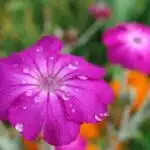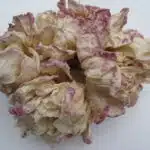As a redleaf rose growing expert, I am pleased to share with you the profile of this magnificent flower. The redleaf rose is an exquisite plant with striking foliage and vibrant blooms that will add beauty and elegance to any garden or landscape. Its unique characteristics make it a popular choice among garden enthusiasts who appreciate its showy display of color and texture.
The redleaf rose is known for its deep green leaves with red hues that darken as the plant matures. It produces large, fragrant flowers in shades of pink, red, and white, which bloom from late spring through early fall. With proper care and maintenance, the redleaf rose can reach a height of three to six feet and spread up to four feet wide. This article will provide valuable insights into the growing profile of the redleaf rose, including its soil requirements, watering needs, pruning techniques, and common pests and diseases that may affect its growth.
Overview Of The Redleaf Rose
The Redleaf rose, also known as Rosa glauca, is a deciduous shrub that belongs to the Rosaceae family. It is native to Europe and Asia and can grow up to 8 feet tall with a spread of 6 feet. The plant’s distinctive features include its blue-green leaves that turn deep red or purple in autumn, and its pink or light purple flowers that bloom from late spring to early summer.
The Redleaf rose has long been associated with symbolism such as love, passion, and elegance. Its vibrant color and sweet fragrance make it an ideal flower for romantic occasions. Moreover, its thorns symbolize protection against harm, making it a popular choice for wedding bouquets.
Caring for Redleaf roses is relatively easy even for beginners. They thrive in full sun but can tolerate partial shade. Pruning should be done in late winter or early spring before new growth appears. Deadheading spent blooms will encourage more flowers to bloom throughout the season. Additionally, regular watering during dry spells is essential to keep the soil moist but not waterlogged. In the next section, we will discuss the soil requirements necessary for healthy growth of Redleaf roses.
Soil Requirements For Redleaf Roses
To ensure that redleaf roses thrive and produce beautiful blooms, proper soil preparation is essential. Start by selecting a well-draining location that receives at least six hours of sunlight per day. Redleaf roses prefer slightly acidic soil with a pH level between 6.0 and 6.5, so it’s crucial to test the soil before planting.
If the soil pH needs adjustment, it’s recommended to add organic matter such as compost or peat moss to lower the pH level or limestone to raise it. It’s important not to add too much of any amendment as this can result in nutrient imbalances and harm the plant’s growth. For best results, consult with a local garden center or extension office for specific recommendations for your area.
Maintaining proper pH levels is critical to redleaf rose health and vitality. In addition, regular soil testing every three years will help ensure that pH levels are maintained within the optimal range for healthy plant growth and flower production.
As we move forward in our discussion about redleaf roses, let us now shift our focus towards understanding their watering needs.
Watering Needs Of Redleaf Roses
Watering frequency is an essential aspect of maintaining the health of redleaf roses. Adequate watering ensures that the plant receives enough moisture and nutrients to grow healthy, vibrant flowers. However, it is crucial to avoid overwatering, which can lead to root rot and other fungal diseases.
To determine the proper watering frequency for your redleaf rose, you should consider several factors. First, check the soil moisture regularly by inserting your finger about an inch deep into the soil. If it feels dry at this depth, it’s time to water. Secondly, take into account the weather conditions in your area. During hot and dry spells, you may need to increase watering frequency.
It is also important to note that the watering needs of redleaf roses may vary depending on their age and size. Newly planted or young plants require more frequent watering than established ones. Additionally, larger plants may require more water than smaller ones due to their increased foliage and root systems.
- Here are some tips for watering your redleaf rose effectively:
- Water deeply but infrequently to encourage deep root growth.
- Avoid getting water on the leaves as this can promote fungal growth.
- Use a soaker hose or drip irrigation system instead of overhead sprinklers.
- Water early in the morning or late in the afternoon when temperatures are cooler.
Now that we have discussed proper watering techniques for redleaf roses let’s move on to their light and temperature preferences. These factors also play a significant role in determining how well your plants will thrive. By understanding these requirements, you can ensure that your redleaf roses continue to grow and bloom beautifully throughout the growing season.
Light And Temperature Preferences
As a redleaf rose growing expert, it never ceases to amaze me how these beautiful flowers can thrive in a variety of light and temperature conditions. While these roses are known for their ability to tolerate partial shade, they truly shine when given full sun exposure. However, it’s important to note that indoor cultivation is possible with adequate artificial lighting, making this plant a versatile option for any gardener.
When it comes to temperature preferences, the redleaf rose is most comfortable in moderate temperatures ranging from 60-75°F (15-24°C). Like many plants, seasonal adjustments are necessary to ensure optimal growth and health during extreme weather conditions. During winter months, it’s important to reduce watering frequency and increase humidity levels to prevent drying out. In the summer heat, be sure to provide ample water and consider adding a layer of mulch around the base of the plant.
In summary, understanding the light and temperature preferences of your redleaf roses is key to ensuring their success in your garden or indoor space. With proper care and attention during seasonal adjustments, these resilient flowers can thrive year-round. In the next section, we will explore pruning techniques for redleaf roses that will help you maintain their beauty and promote healthy growth.
Pruning Techniques For Redleaf Roses
After discussing the light and temperature preferences of redleaf roses, it is important to move onto another aspect of their care: pruning. Pruning is essential for maintaining the health and appearance of your redleaf rose plant. It involves removing dead, diseased, or damaged wood and shaping the plant for optimal growth.
Timing considerations are important when it comes to pruning redleaf roses. The best time to prune is in late winter or early spring before new growth starts to emerge. This allows for a clean cut without damaging any new buds or shoots. However, if there are any dead or diseased branches that need to be removed, they should be done as soon as possible regardless of the season.
There are several training methods that can be used when pruning redleaf roses. The first method is called heading back, which involves cutting back long stems to encourage lateral growth and produce more flowers. Another method is called thinning out, where entire branches are removed to improve air circulation and prevent disease. It’s important to choose the right training method based on the needs of your specific plant.
- When pruning redleaf roses, consider the timing of the prune
- Late winter/early spring is best
- Dead or diseased branches can be pruned anytime
- There are different training methods for pruning redleaf roses
- Heading back encourages lateral growth and more flowers
- Thinning out improves air circulation and prevents disease
Moving on from pruning techniques, another important aspect of caring for redleaf roses is fertilization. Proper fertilization can improve plant health and promote strong growth. In order to ensure proper fertilization, it’s important to understand when and how often to apply fertilizer.
Transitioning into the next section about fertilizing redleaf roses, it’s essential to note that fertilization should never replace proper pruning techniques or other aspects of care. By following all necessary steps in caring for your redleaf rose plant, you can ensure a healthy and beautiful addition to your garden.
Fertilizing Redleaf Roses
- Redleaf roses require a nutrient-rich fertilizer for optimal growth and flowering.
- Depending on the soil type, the fertilizer type should either be organic or inorganic.
- Fertilizer should be applied every two to four weeks during the growing season.
- As the redleaf roses are perennials, it is important to feed the plants in the fall for winter protection and for spring growth.
Fertilizer Types
As a redleaf rose growing expert, it is essential to consider the type of fertilizer to use on your plants. The two main types of fertilizers are organic and synthetic. Organic fertilizers come from natural sources, such as composted manure, bone meal, or blood meal. They provide a slow-release form of nutrients that gradually release into the soil over time. Synthetic fertilizers are human-made and have high concentrations of nitrogen, phosphorus, and potassium. They provide an immediate source of nutrients to the plant.
The frequency of fertilizer application is also crucial when it comes to redleaf roses. Over-fertilizing can cause excessive growth, which can make the plant more susceptible to diseases and pests. It can also lead to imbalances in soil pH levels and nutrient uptake by the plant. On the other hand, under-fertilizing can lead to stunted growth and poor flower production. As a general rule, redleaf roses should be fertilized every four to six weeks during their growing season.
When deciding on which type of fertilizer to use for your redleaf roses, it ultimately comes down to personal preference and gardening philosophy. Organic fertilizers tend to be more environmentally friendly and provide long-term benefits for soil health. Synthetic fertilizers may offer faster results but may also have negative impacts on soil health over time. Regardless of which type you choose, remember that proper application frequency is critical for optimal growth and flower production in your redleaf roses.
Fertilizer Frequency
As a redleaf rose growing expert, one of the most critical factors to consider when fertilizing your plants is the frequency of application. Redleaf roses require regular fertilization to promote healthy growth and optimal flower production. However, excessive or inadequate fertilizer application can lead to problems such as disease susceptibility or stunted growth.
To ensure the best practices for your redleaf roses, it is recommended to fertilize them every four to six weeks during their growing season. This interval allows for a consistent supply of nutrients without over-fertilizing, which can cause excessive growth and other problems. Additionally, using organic options for fertilization can provide a long-term benefit for soil health and plant growth.
Proper fertilizer frequency will help maintain the health and beauty of your redleaf roses. By following best practices and using organic options when possible, you can ensure that your plants receive the necessary nutrients while avoiding harmful effects on soil health and environmental impact. Remember that your skills as a redleaf rose growing expert can serve others by providing beautiful blooms for all to enjoy!
Propagating Redleaf Roses
Propagating Redleaf Roses can be done through different methods such as cuttings, layering, and grafting. Cuttings are the most common method used by gardeners since it is simple and affordable. To propagate using this method, take a stem cutting from a healthy parent plant during spring or summer. Cut 6 inches of the stem with a sharp and clean tool, remove any leaves attached to the bottom half of the stem, and dip in rooting hormone before planting in a potting mix. Keep the soil moist and place the container in a warm location with indirect light until roots develop.
Another propagation method that can be used for Redleaf Roses is layering. This option is beneficial for plants that have low rooting success rates when propagated through cuttings. Layering involves bending a flexible branch down to touch the ground without breaking it off from the parent plant. Make sure to wound the area where it will touch the soil and cover it with compost or mulch. Water frequently and once roots develop, separate and replant into individual containers.
The best time to propagate Redleaf Roses is during early spring when new growth begins or late summer just after flowering has finished. This timing ensures that there is enough energy stored in the plant’s system to support growth after propagation. It is also important to choose healthy parent plants with no signs of pests or diseases as this can affect propagation success rates.
Moving on from propagation methods, it is vital to know about common pests and diseases that can affect Redleaf Roses’ health. These issues include blackspot fungus, powdery mildew, aphids, spider mites, rose slugs, and Japanese beetles. Understanding how these pests affect your plants will help you identify them quickly so that you can take appropriate measures like using insecticidal soap or horticultural oil sprays to prevent further damage to your roses’ health.
Common Pests And Diseases
Common Pests and Diseases:
Redleaf roses are vulnerable to various pests and diseases, which can cause significant damage to the plant’s overall health and appearance. Some of the most common pests include aphids, spider mites, thrips, and Japanese beetles. These insects feed on the plant’s leaves and buds, causing them to wilt or drop prematurely. Additionally, fungal diseases such as black spot and powdery mildew can infect redleaf roses if they are not maintained properly.
Preventative measures play a crucial role in safeguarding redleaf roses from pests and diseases. One of the effective methods is to maintain proper hygiene by removing dead or infected plant parts regularly. This activity minimizes the chances of pests and diseases spreading rapidly throughout the plant. In addition, keeping an eye out for early signs of infestations can help prevent further damage. Natural remedies such as neem oil, garlic spray, or soap solution can also be used as a preventative measure against pests.
Despite taking preventive measures, redleaf roses may still fall prey to pests or diseases at times. Natural remedies are often an excellent alternative to chemical pesticides that may harm beneficial insects such as bees or ladybugs that pollinate flowers. For instance, spraying a mixture of water and baking soda on plants infected with powdery mildew can help control its spread effectively. Similarly, introducing predator insects like ladybugs can help eradicate aphids without using harsh chemicals.
Tips for growing redleaf roses in containers will follow this section about common pests and diseases.
Tips For Growing Redleaf Roses In Containers
Growing redleaf roses in containers can be a rewarding experience, as these plants are easy to care for and add a pop of color to any space. However, selecting the right container is crucial for the success of your redleaf rose. Choose a container with adequate drainage holes at the bottom to prevent waterlogging and root rot. The size of the container should also be considered as it will determine how much soil and water the plant can hold.
Pest management is another key aspect of growing redleaf roses in containers. Pests such as aphids, mites, and thrips can damage your plants if left unchecked. To prevent these pests from infesting your redleaf rose, keep the plant healthy by providing it with enough sunlight, water, and nutrients. You can also use organic pesticides or insecticidal soap to control pests.
To ensure that your redleaf rose thrives in its container environment, choose varieties that are suitable for growing in pots. Some popular varieties include ‘Red Ribbons,’ ‘Crimson Bouquet,’ and ‘Sweet Chariot.’ These varieties have compact growth habits and produce stunning blooms that will brighten up any space. When selecting redleaf rose varieties to consider for container growing, consider factors such as color preference and bloom time for optimal enjoyment of this beautiful flower.
Redleaf Rose Varieties To Consider
Having a redleaf rose in your garden can be a great way to add color and life to the outdoor space. There are many varieties of redleaf roses available, each with unique characteristics that make them stand out from the rest. In this section, we will take a closer look at some of the top redleaf rose hybrids that you can consider.
One of the best things about growing redleaf roses is that they pair well with other plants. Best redleaf rose companion plants include lavender, salvia, and catmint. These plants not only complement the beauty of redleaf roses but also attract pollinators such as bees and butterflies to your garden. Additionally, planting companion plants alongside your redleaf roses can help improve soil quality by providing important nutrients and preventing soil erosion.
When it comes to choosing the right variety for your garden, there are several options to consider. Some popular hybrids include ‘Red Eden’, ‘Burgundy Iceberg’, and ‘Burgundy Meidiland’. ‘Red Eden’ is a climbing rose with deep crimson petals that bloom throughout summer and fall. ‘Burgundy Iceberg’ has dark burgundy-red foliage and produces clusters of white flowers that fade to pink over time. Finally, ‘Burgundy Meidiland’ is a low-growing shrub with dark green leaves and velvety burgundy-red blooms that are perfect for borders or containers. With so many beautiful options available, you’re sure to find a redleaf rose hybrid that suits your style and preferences.
Incorporating these top redleaf rose hybrids into your garden along with their best companion plants can create an eye-catching display while providing benefits for other plants in your outdoor space. Remember to choose the right variety based on your gardening needs and preferences as each hybrid has its unique features. With proper care and attention, these beautiful roses can bloom year after year, bringing joy to those who see them!
Conclusion
The Redleaf Rose is a stunning addition to any garden, with its striking red foliage and delicate pink blooms. To grow this beautiful plant successfully, it’s important to pay close attention to its soil requirements, watering needs, and light preferences. Proper pruning techniques and propagation methods can also help ensure the health and longevity of your Redleaf Roses.
When selecting soil for your Redleaf Roses, look for well-draining options that are rich in organic matter. Keep the soil moist but not waterlogged, as too much moisture can lead to root rot. The Redleaf Rose thrives in full sun to partial shade conditions and prefers temperatures between 60-75°F.
Pruning should be done in late winter or early spring before new growth appears. Cut back any dead or damaged wood and trim back the remaining branches by one-third to encourage fuller growth. Propagation can be done through softwood cuttings taken in early summer or hardwood cuttings taken in late fall.
Be mindful of common pests such as aphids and spider mites, as well as diseases like black spot and powdery mildew. Regularly inspecting your plants can help catch any issues early on.
For those who want to grow Redleaf Roses in containers, select a pot that is at least 18 inches deep with drainage holes. Use a high-quality potting mix and fertilize regularly during the growing season.
Overall, with proper care and attention, Redleaf Roses can thrive beautifully in any garden or container setting. Their unique coloration adds depth and complexity to any landscape, making them an excellent choice for both novice and experienced gardeners alike.
Image Credits
- “Redleaf Rose (Rosa glauca or Rosa rubrifolia)” by Distant Hill Gardens (featured)





























